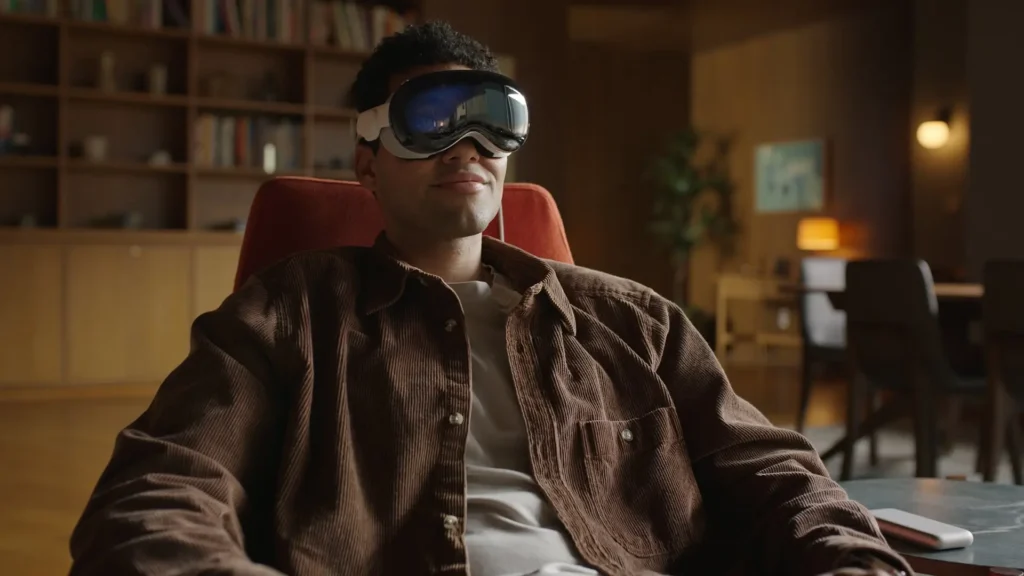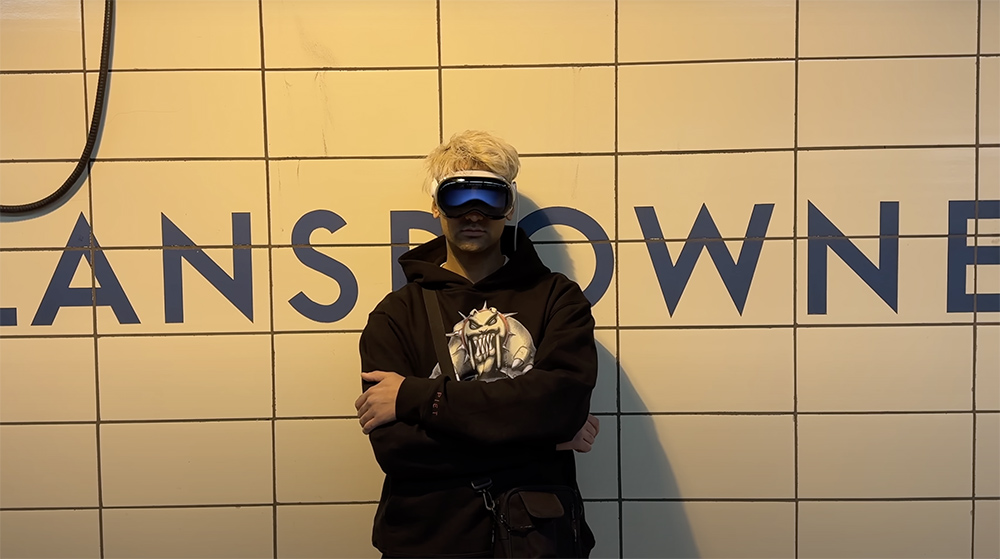We’re being bombarded with it gradually: the introduction of Apple Vision Pro into our lives. Despite the fact that the glasses have only been on the American market since the second of February, the technology is already indispensable in our lives. To be fair, that’s usually how it goes with Apple innovations. Lots of hype for a technology we’ve known for a while.
They call it spatial computing; it’s one of several human-computer interaction techniques perceived by users as happening in the real world, in and around their natural body and physical environment, rather than being confined to computer screens. Of course, there are countless VR glasses on the market. Alongside the Vision Pro, there’s the Hololens, Metaquest Pro, and the Magic Leap 2, for example.
These are impressive devices with cutting-edge technologies. Think Mixed Reality (MR) and Virtual Reality (VR) features, advanced display technologies, numerous cameras, sensors, and tracking software, along with 3D audio. However, they all share one thing in common – they’re quite expensive. For a package of technology like this, you’ll easily shell out three to five thousand euros. Not as accessible as one might think. This is also the primary reason why spatial computing is not yet the norm.

Besides being expensive, these devices face the following criticism from skeptics:
- Prolonged use can induce nausea and dizziness, also known as cyber sickness.
- They consume a tremendous amount of energy.
- They use many valuable materials, which are already scarce.
- They are data mines, capable of collecting vast amounts of personal data, including physical movements, voice commands, and even eye tracking. Let’s hope they handle this discreetly!
But as tech improves, becomes newer, and optimizations are made, the technology will become more affordable and better within a few generations, and the initial issues will disappear. In that respect, the first users are kind of like guinea pigs.
Despite starting with a critical tone, we must also acknowledge that they are indeed impressive pieces of technology. Besides consumer use, countless industries will greatly benefit from spatial computing. Another fantastic example of groundbreaking tech in the realm of spatial computing is Google’s Starline.
The bizarre technology is certainly an example of how our communication can change in the coming years. Project Starline, still in its infancy, promises a future where video calling is so lifelike that it seems like your conversation partner is sitting in the room with you, thanks to the integration of 3D telepresence.
Perhaps we’ll be rid of the heavy glasses sooner than we think. What’s certain is that we will sooner or later distance ourselves from our familiar mobile phones. Several Apple insiders suggest that Apple will stop making iPhones within ten years. This is remarkable, considering the iPhone accounts for approximately 52% of Apple’s revenue. Apple wants to remain at the forefront of technology, including spatial computing.
The new technology will certainly also influence how we consume. We are facing a revolution in how we use apps, create content, and, above all, experience e-commerce.
How does the near future of e-commerce look?
We stand on the brink of a big shift in how we consume content. In our article on user-generated content and social shopping, we explored the fact that social media is evolving into social shopping. When viewed through the lens of spatial computing, it becomes evident that we are on the start of a revolution in UX and UI. Our shopping experience is poised for a complete transformation. Let’s offer a sneak peek of what you can expect.
Personalised Shopping Experiences
Consumer expectations are sky-high these days. We’re already accustomed to it through our social media usage. What we see in our timeline can be entirely different from what you’re being shown. This is because people crave personalization; it provides a sense of comfort. It all has to do with the path of least resistance. Consumer expectations for personalization are high, with 71% considering it a must-have, and 76% getting frustrated when brands fall short in showing personalized content. This important insight underscores the role of personalization in our experience.
Spatial computing is ready to support that. Here are a few examples:
- Virtual try-ons: Customers can try on clothing, accessories, or even makeup virtually, enhancing the shopping experience and reducing return rates.
- Interactive product demos: Explore products in 3D, rotate, open, or even simulate the use of the product through intuitive gestures and touch.
- Group shopping sessions: Allow multiple users to shop together virtually, making it ideal for gift buying or collaborative purchasing decisions.
This will become the new norm and will bring about significant shifts in the digitalization of products and services.
Customer Support
As time passes, many of us feel the weight of age creeping in, especially those who’ve endured the endless waits of customer service calls. But there’s a glimmer of hope in chatbots. While they’re changing the game, good old-fashioned customer support remains vital for businesses and customers alike.
With spatial computing, it’s possible to communicate live with customer care and address potential issues on the spot. This saves a lot of time and frustration. Imagine you’re putting together an IKEA cabinet and you’re struggling. You can simply get live assistance from a staff member or, even better, a chatbot, and solve the problem quickly.
What about traditional retail? Have a question about a product and don’t immediately see a staff member who can help? With spatial computing, you can find all the information about a product simply by speaking your question. You’ll be informed instantly. Another example: suppose you can’t find a product or product group. Ask your question and be guided to the product without any trouble. The only downside is that it definitely sets us further away from humanity, and compromises our social skills.

Conversational Commerce has Finally Arrived
This brings us to the biggest factor of the shift: Conversational Commerce: A prediction by many, is a revolution we all need to be aware of. The term says it all. Shopping while having a conversation. Thanks to AI and ML techniques that are already commonplace, we can receive personalized advice and unfiltered opinions from machines.
When consumers are asked to define personalization, they associate it with: “positive experiences that make them feel special.”
What would something like this look like? Imagine you’re on TikTok and you see a jacket you must have for the upcoming spring. You open your chatbot, share your budget, size, and personal preferences. The chatbot presents you with various options, and with the help of AR filters, you try on the jacket at home and ask any questions you have. The chatbot guides you through the purchase process, from payment methods to shipping options. Additionally, it can provide updates on the shipment’s arrival and even conduct after-sales follow-ups to ensure you’re truly satisfied with the product. Essentially, it’s your own stylist and personal assistant in one.
This fascinating evolution becomes even more intriguing when viewed in the context of discovery-driven exploration – the growing tendency among consumers to explore comprehensive product details across various platforms before finalizing a purchase.
Consider the prominent presence of Gen Z, who now conducts nearly 40% of product searches on platforms like TikTok and Instagram instead of solely relying on Google. Imagine the potential of offering customers a customized tool on your e-commerce platform, providing personalized insights that precisely meet their individual needs. It’s getting there!

Moreover, personalization marketing has real benefits for companies: it can reduce customer acquisition costs by up to 50 percent, increase revenues by 5 to 15 percent, and boost marketing ROI by 10 to 30 percent. Personalization has also been shown to improve performance and provide better customer outcomes.
In reality, we’ve been familiar with conversational commerce for quite some time. Precisely for 10 years, to be exact. Siri, Alexa, or the Google Assistant are examples of assistants that do exactly this, and to some extent, they do it quite well. However, the groundbreaking promise that voice assistants would dramatically influence our shopping behavior has turned out to be, well, a flop. It never really led to a global success or acquisition. It’s only since the full breakthrough of AI and ML that voice assistants have been widely accepted. The learning curve of the chatbots we’re familiar with today is still so steep that there’s much more to come in the coming years. The promise of 10 years ago is now starting to become a reality.
Beyond all else, conversational commerce could arguably be deemed the biggest revolution in the quest to reach greater inclusivity in global browsing and e-commerce.

Why Most Websites Still Aren’t Inclusive
With all this knowledge, let’s return to the main focus of this article: How Spatial Computing is Shaping Inclusivity. This is quite a statement, so let start to elaborate. In today’s digital world, online interactions are heavily influenced by two key factors: visual appeal and easy navigation via mouse or touch screen.
Digital platforms engage users with compelling visuals, interactive videos, and subtle design features such as font styles, color schemes, and intuitive icons. These elements guide users through content, helping them make informed decisions, whether it’s gathering information, entertainment, or making a purchase.
However, amidst the focus on engaging content and inclusivity, one critical issue is often overlooked: web accessibility. Globally, around 2 billion people experience vision impairments, that’s nearly one out of four facing sight-related challenges. Among them, 240 million have significant visual impairments (less than 30% vision), and 40 million are completely blind. This problem is worsened by conditions like presbyopia, primarily caused by excessive screen time, and aging. The economic impact of aging underscores the importance of addressing these issues seriously.

Individuals with low vision often struggle with websites that use low-contrast color schemes. Similarly, blind users rely heavily on assistive tools like screen readers, but their effectiveness depends on website accessibility features. Without clear indicators, such as indicating the clickability of buttons or hyperlinks, users risk missing vital information or becoming stuck in their online journey.
Imagine being someone with poor vision, or perhaps you’re dealing with it yourself, needing constant assistance to navigate something as “simple” as a website. This task can be a nightmare, reminding you of your dependence on others. Clearly, this issue deserves more attention.
To avoid hypocrisy, we must acknowledge that The Next Cartel has room for improvement in enhancing inclusivity, especially in terms of UX/UI for the visually impaired.

Voice-controlled assistants offer significant potential for improving accessibility and inclusivity. When combined with machine learning and artificial intelligence, these tools can greatly enhance the lives of millions worldwide. Frankly, spacial computing holds the key to inclusivity on the web, also called: digital accessibility.
So, what is digital accessibility? It’s about providing an online experience free from barriers, enabling users to perceive and interact with content using their preferred screen-reading technology or accessibility device, without assistance.
The consequences of inaccessible design are significant: blind internet users abandon roughly two-thirds of their e-commerce interactions due to accessibility issues, seeking more inclusive alternatives elsewhere. In conclusion, the imperative for inclusivity in web design cannot be overstated. As technology continues to evolve, so must our commitment to ensuring that digital platforms are accessible to all.
Moving forward, it’s crucial for designers, developers, and businesses alike to prioritize digital accessibility in their initiatives. This involves implementing guidelines such as the Web Content Accessibility Guidelines (WCAG) to ensure that websites are perceivable, operable, understandable, and robust for all users, regardless of their abilities.
Fostering a culture of empathy and awareness within the tech industry is essential. By actively seeking out feedback from users with disabilities and incorporating their insights into the design process, we can create more inclusive digital experiences.
Ultimately, the goal is not just compliance with accessibility standards, but rather the creation of digital spaces that empower and enrich the lives of all users. By embracing diversity and championing inclusivity, we can pave the way for a more equitable and accessible online world.













